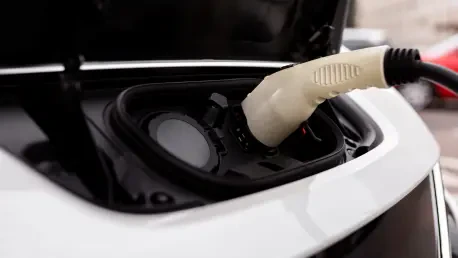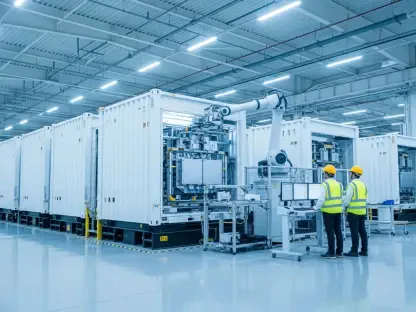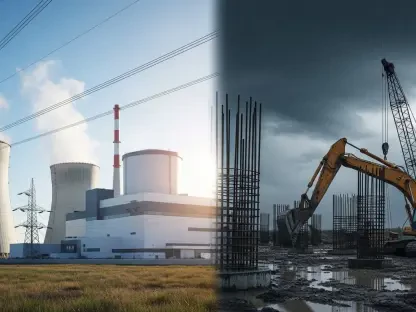Revving Up for an Electric Revolution
Imagine a future where India’s bustling streets hum with the quiet efficiency of electric vehicles (EVs), slashing carbon emissions and fueling a monumental economic shift. With EV penetration at a mere 7.6% of total vehicle sales in the current landscape, the nation stands at a pivotal crossroads, facing an ambitious target of achieving 30% EV adoption by 2030. This goal presents both a daunting challenge and an unparalleled market opportunity valued at $200 billion. This analysis dives into the intricacies of India’s EV sector, exploring current trends, persistent barriers, and strategic forecasts that could transform the transportation landscape. By dissecting market dynamics and policy frameworks, the goal is to illuminate the path toward sustainable mobility and position India as a global EV powerhouse.
Market Trends and DatMapping the EV Landscape
Sales Growth and Segment Disparities
India’s EV market has shown promising traction in specific segments, particularly with electric two- and three-wheelers, which dominate the vehicle population at 75%. Sales in this category have surged significantly over recent years, reflecting growing consumer acceptance driven by affordability and urban utility. However, the broader market reveals stark disparities—electric buses and passenger cars exhibit sluggish growth, while long-haul electric trucks remain nearly absent from the commercial space. This uneven adoption highlights a critical trend: the market is heavily skewed toward smaller, personal mobility solutions, necessitating targeted interventions for heavier, commercial vehicles to balance the ecosystem.
Infrastructure Realities and Usage Gaps
Charging infrastructure, a cornerstone of EV expansion, presents a mixed picture. While the ratio of one charger per 14 electric cars appears favorable on paper, actual utilization remains low due to suboptimal placement and limited public awareness. Many stations are situated in inaccessible areas, deterring usage and amplifying range anxiety among potential buyers. This trend underscores a broader market challenge—without a reliable and strategically located network, consumer confidence in EVs, especially for long-distance or commercial applications, will continue to lag, stifling broader market penetration.
Cost Dynamics Impacting Adoption Rates
High upfront costs remain a formidable barrier, particularly for commercial segments like buses and trucks, which are vital for decarbonizing logistics and public transport. Small fleet operators, who form the backbone of India’s transportation sector, often find the initial investment prohibitive compared to traditional internal combustion engine (ICE) vehicles. Even with existing incentives, the financial burden limits market entry, pointing to a clear trend of affordability challenges that must be addressed to unlock demand across diverse vehicle categories and ownership models.
Projections and Future Analysis: Bridging the 30% Gap
Policy Shifts and Regulatory Forecasts
Looking ahead, the market is poised for transformation through anticipated policy reforms. A shift from voluntary incentives to mandatory zero-emission vehicle (ZEV) adoption is projected to catalyze growth, creating a stronger demand pull. Tighter Corporate Average Fuel Efficiency (CAFE) norms and disincentives for ICE vehicles are expected to further tilt the competitive balance toward EVs. If implemented effectively from 2025 to 2030, these measures could close the significant gap between the current 7.6% penetration and the 30% target, reshaping market dynamics in favor of sustainable mobility.
Infrastructure Expansion and Urban Focus
Future growth hinges on aggressive infrastructure development, with projections emphasizing the need for robust charging networks along major freight corridors and in high-traffic urban zones. Initiatives like urban fleet electrification in select pilot cities are forecasted to serve as scalable models, demonstrating viability for broader rollout. Dedicated EV power lines and public-private partnerships are also anticipated to ensure reliability and accessibility, addressing current usage gaps. Such strategic expansions could significantly boost market confidence and adoption rates over the next five years.
Technological Advancements and Cost Reductions
Technological innovation offers a bright outlook for the EV market, with battery storage improvements and cost reductions projected to enhance competitiveness against ICE vehicles by the late 2020s. Emerging business models, such as battery leasing, are expected to alleviate upfront cost pressures by separating battery expenses from vehicle purchases. These advancements, coupled with increased local manufacturing investments, could position India as a global hub for EV production, capitalizing on the projected $200 billion market opportunity and driving economic growth alongside environmental benefits.
Reflecting on the Path Traveled
In retrospect, the journey of India’s EV market reveals both remarkable potential and persistent hurdles that have shaped its trajectory. The dominance of two- and three-wheelers in sales underscores a unique market structure, while gaps in infrastructure and affordability for commercial vehicles expose systemic challenges that demand attention. Projections for policy mandates and technological breakthroughs paint a hopeful picture, suggesting that the 30% adoption target by 2030 is within reach if strategic actions are prioritized. Moving forward, stakeholders need to focus on actionable steps—policymakers must enforce ZEV mandates and streamline regulations, businesses are encouraged to adopt innovative financing like battery leasing, and infrastructure planners must target high-density areas for charging networks. By aligning these efforts, India could not only meet its ambitious goals but also set a precedent for sustainable transportation leadership in the Global South, turning challenges into a catalyst for enduring change.









